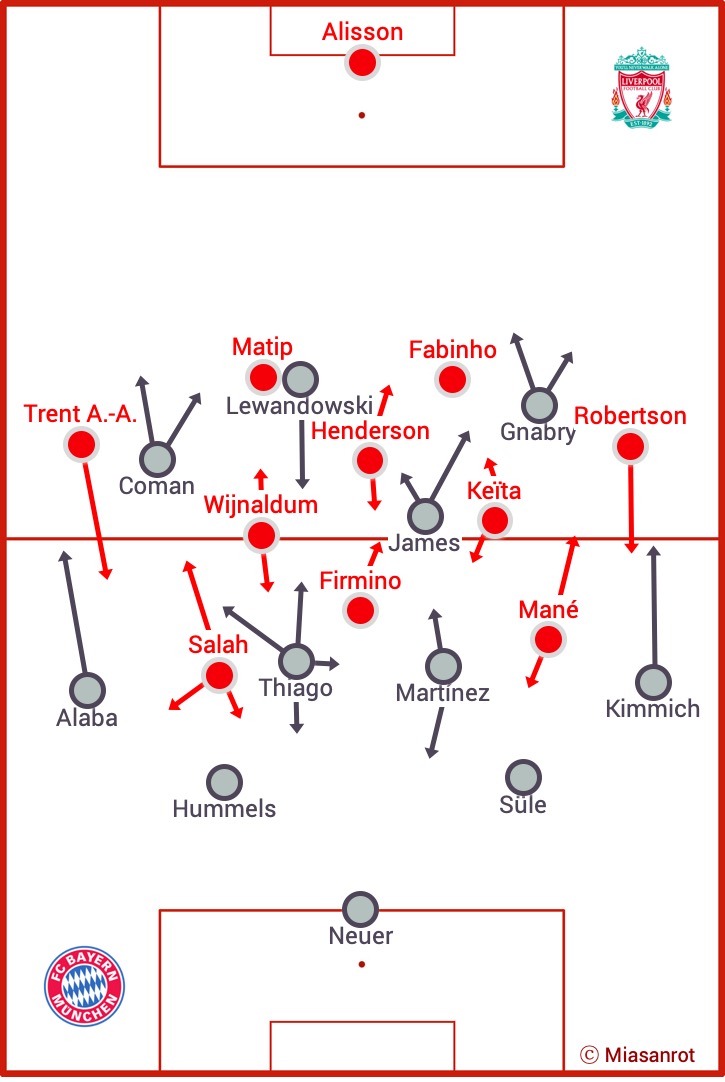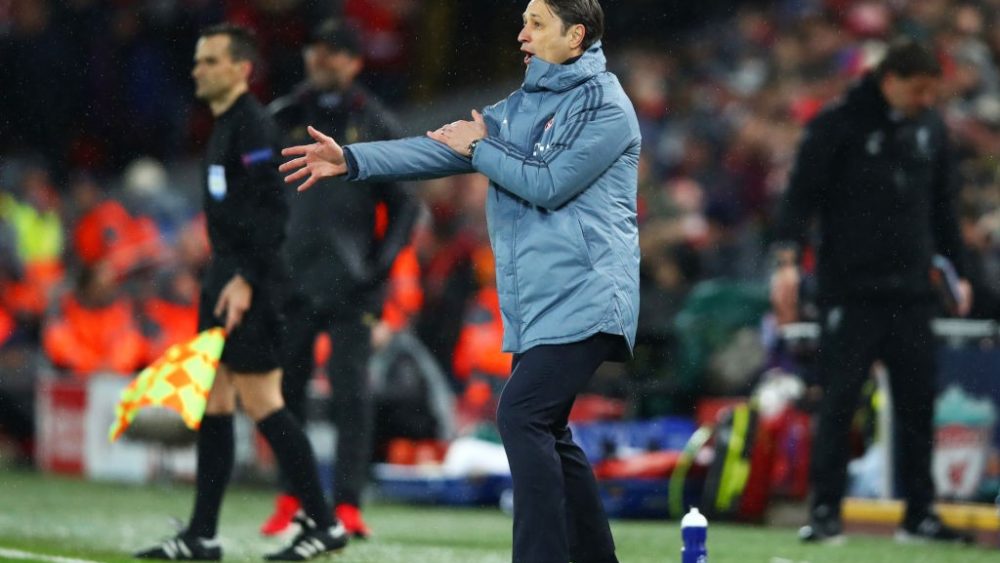Strong defence enough for a draw at Anfield
Before the game, Liverpool could be seen as the slight favourite considering their performance in the league and the fact that Liverpool’s strengths are perfect to exploit Bayern’s weaknesses. However, in an intense game, Liverpool struggled to create a ton of chances and Bayern Munich showed one of their better performances this season. In the end Bayern was a lucky that Liverpool didn’t convert one of their chances. Nevertheless the team showed that they can still compete with the best teams in Europe.
 But, what happened in those 90 minutes and why did both teams struggle to score?
But, what happened in those 90 minutes and why did both teams struggle to score?How to overcome Liverpool’s pressing?
This question was probably the one Niko Kovac asked himself multiple times. A team coached by Jürgen Klopp usually uses aggressive pressing and quick counterpressing after losing the ball. Manchester City for instance struggled against the high pressing of Liverpool in the Champions League last season.
You have to find the balance between playing out of the back and choosing long balls to avoid the risk of loosing the ball against Liverpool’s forwards. By pressing high, the first line of Klopp’s team tries to close passes in the centre while simultaneously pressing the ball carrier.
Usually, Liverpool lines up in a 4-3-3 in which both central midfielders used man-orientations in their defending against Thiago and Martínez. Against Bayern, Jürgen Klopp didn’t change that. The Reds are outstanding in identifying pressing triggers. Those triggers can be specific passes to a player or in a specific space or a bad first touch. Therefore, Liverpool waited in a more passive shape in Bayern’s half only to close passing lanes. Then they start pressing when the ball travelled to one of the centre-backs.
Mohammed Salah and Sadio Mané attacked Hummels and Süle by using a curved run. The goal was to force Bayern in the centre. Mané and Salah attacked the centre-backs from the side closing the passing lane to Kimmich and Alaba with their cover shadow.
Firmino on the other hand waited in the middle. He could pick up the dropping defensive midfielder or press Manuel Neuer once he received the ball. Behind Firmino, Liverpool was waiting with a three-man midfield, ready to step up and press whenever it was necessary. However, Bayern did a good job in keeping the balls in those zones. James and Thiago are both press resistant which helped Bayern to progress the ball through the centre.
Well-structured build-up
Although, Bayern fielded pressing resistant midfielders, they rarely could play through the centre. In the first half the shape in build-up was well-connected allowing Bayern to overcome Liverpool’s pressing line centrally. However, we discussed the problems Niko Kovač‘s team has in possession multiple times. And those got visible in the second half again.
The lacking connections to the halfspace and centre once the ball travelled to the wing. Bayern Munich had the courage to build-up with flat and short passes instead of choosing the long ball. In order to stretch Liverpool’s pressing and providing enough players in deeper zones, Bayern created a five-man line including goalkeeper Manuel Neuer who was involved regularly. Furthermore, the full-backs stayed deeper creating an overload against the high pressing block of Klopp’s side.
As a consequence, Bayern were able to circulate the ball quite well against the high pressing. By attracting the opponent on one side, they could create space for the full-backs on the other side. In the follow-up of those plays they tried to move the ball in the open space. Due to pressing of Liverpool, Manuel Neuer was the player who had to play those chip passes to the full-backs.
The well-known offensive problems
In that way, Bayern was capable of overcoming Liverpool’s pressing. In the first half they were able to progress the ball nicely out of that structure. By finding Lewandowski, Thiago or James with diagonal passes. In the second half on the other hand, Bayern had to choose the long ball or the flat vertical pass because less passing options were available.
Either Bayern’s spacing was poor and the passing options were positioned too far away from each other or they simply attacked with a small number of players giving Liverpool an overload. Then, Niko Kovač‘s team was rarely capable of creating good chances as it was the case in the second half. The individual class was enough to dribble out of underload situations. However, those actions are low probability actions and resulted in some dangerous turnovers.
Overall, Bayern wasn’t able to create multiple chances. This isn’t a particularly bad thing, considering Kovač‘s side played at Anfield. Although, they often progressed through Liverpool’s pressing nicely, the missing offensive structured avoided more dangerous situations. It is actually hard to say after a good performance of Bayern, but with clear guidelines in possession, Bayern would have been able to produce more high-quality chances.
No chances for Liverpool
The positive aspect of the game was clearly Bayern’s defensive performance. Since the winter break Bayern conceded a goal in every match. No wonder that many fans feared a catastrophe at Anfield. Although, multiple players made individual mistakes over the past weeks, against Liverpool every player was at his best defensively.
They lined-up in a 4-4-2 against the ball with James joining Lewandowski in the first line. Over the course of the first 30 minutes, the pressing was really effective. Bayern pressed higher and closed the passing lanes for Liverpool’s centre-backs Fabinho and Joel Matip. Consequently, Liverpool struggled to create any chances. The good defensive performance of Bayern was definitely a factor, also silencing the Liverpool fans.
Over the course of the game Bayern dropped deeper and deeper with their defensive block. However, the defensive shape was compact. The individual duels were won and Manuel Neuer didn’t have to save many shots.
One concern was the lack of compactness when Bayern pressed higher. Considering the second leg, the space between the lines can be a major advantage for Liverpool when they are capable of using it. Liverpool overloaded the centre with their three midfielders, the wingers in the halfspace and Firmino who would drop occasionally.
Liverpool moved flexible and triggered Bayern’s pressing with simple passes only to open space somewhere else. For example, Mané would drop deeper. Consequently, Thiago had to follow him. The winger of Liverpool simply played the backward pass to the centre-back. However, his teammates moved intelligently and Fabinho found an open passing lane in the space behind the midfield. Especially, the role of Firmino who dropped into midfield and pulled a defender with him could be dangerous for Bayern in the second leg.
Conclusion
Bayern played well away at Anfield. Especially the defensive performance was outstanding as well as the courage and technical ability they showed during the build-up phase in their own half. However, the problems Kovač‘s team showed all season prevented an even better result. At home Bayern has to play at least as well as in the first leg to advance to the next round. Liverpool didn’t seem to perform at their absolute best. In Munich Klopp’s side will receive more space which they eventually can exploit. Nevertheless, the match-up is completely open and we can look forward to the second leg.












Klasse Ausarbeitung.
Schade, dass das nur im englischen Bereich “versteckt” wird.